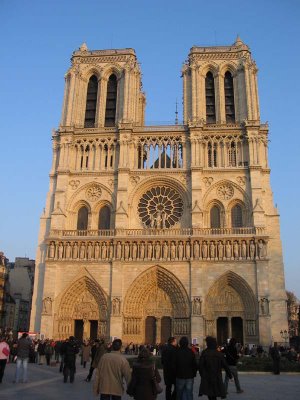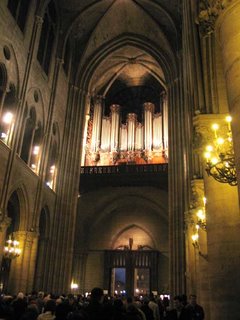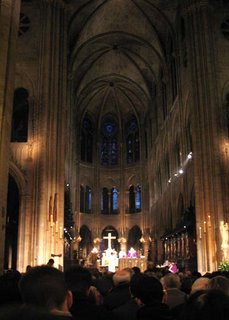 On Sunday, we led our students through the Cathedral of Notre-Dame, a place that is so crowded with tourists most of the time -- often of the videotaping, foot-scuffling en masse, oblivious type -- it would seem to be impossible to have an aesthetic experience there, not to mention a religious one. However, I had both, yet again, first in the morning, when we sat in the nave to take part in the service of Lauds. Unlike the church in much of the world, the Cathedral of Notre-Dame, at least part of the week, observes parts of the Divine Office, which was historically a substantial part of the reason why much sacred music was composed. Indeed, this particular cathedral was the seat of a legendary medieval maîtrise, for whom both Leonin and Perotin composed their lavish new styles of polyphony, marking Notre-Dame as one of the cradles of European music, along with San Marco in Venice, the Cappella Sistina in Rome, and a few others. The Divine Office, not just the Mass, was the glory of these churches. The music for the service was very simple, French translations of the psalms and antiphons, set to basic tones, some of them modified from Gregorian ones. I wonder how much, if ever, the modern musical team programs Notre-Dame polyphony. I would dearly love to hear how it sounds, performed well in that choir.
On Sunday, we led our students through the Cathedral of Notre-Dame, a place that is so crowded with tourists most of the time -- often of the videotaping, foot-scuffling en masse, oblivious type -- it would seem to be impossible to have an aesthetic experience there, not to mention a religious one. However, I had both, yet again, first in the morning, when we sat in the nave to take part in the service of Lauds. Unlike the church in much of the world, the Cathedral of Notre-Dame, at least part of the week, observes parts of the Divine Office, which was historically a substantial part of the reason why much sacred music was composed. Indeed, this particular cathedral was the seat of a legendary medieval maîtrise, for whom both Leonin and Perotin composed their lavish new styles of polyphony, marking Notre-Dame as one of the cradles of European music, along with San Marco in Venice, the Cappella Sistina in Rome, and a few others. The Divine Office, not just the Mass, was the glory of these churches. The music for the service was very simple, French translations of the psalms and antiphons, set to basic tones, some of them modified from Gregorian ones. I wonder how much, if ever, the modern musical team programs Notre-Dame polyphony. I would dearly love to hear how it sounds, performed well in that choir.
 I am not sure which of the cathedral's organists was playing for this service, but the music -- improvised, I believe, in the legendary tradition of French organists -- was of the visionnaire style associated especially with Olivier Messiaen, often dissonant and searing in registration. As the final improvisation ended, we were showing the students silently around the outer perimeter of the building. All but one of them has had my Humanities class, where we study this particular building as our example of the French Gothic style of architecture, so there was not much I needed to say. As we were transfixed by the penetrating blue light of the transept rose window, the 10 am Gregorian Mass began, chanted in Latin by a very good male schola. It was the perfect demonstration of how musical and aesthetic experience can combine -- those sounds, that elevated place, that light -- to melt the most stubborn of hearts.
I am not sure which of the cathedral's organists was playing for this service, but the music -- improvised, I believe, in the legendary tradition of French organists -- was of the visionnaire style associated especially with Olivier Messiaen, often dissonant and searing in registration. As the final improvisation ended, we were showing the students silently around the outer perimeter of the building. All but one of them has had my Humanities class, where we study this particular building as our example of the French Gothic style of architecture, so there was not much I needed to say. As we were transfixed by the penetrating blue light of the transept rose window, the 10 am Gregorian Mass began, chanted in Latin by a very good male schola. It was the perfect demonstration of how musical and aesthetic experience can combine -- those sounds, that elevated place, that light -- to melt the most stubborn of hearts.
A place like this spoils you forever for, or rather purifies you from, the popularized musical rubbish and the demotic and blasé architectural and artistic style of most modern Catholic parishes. The Catholic Church is in possession of the some of the most glorious musical and artistic traditions in the world, most totally ignored by the modern church. Not that we have to rely only on the past either, but the church has mostly abandoned its position as the greatest patron of the arts.
 We could not stay for the whole Mass, but I was able to come back Sunday evening for the 6:30 pm Mass, after Vespers. For that service, Olivier Latry was at the grande orgue, one of the most brilliant organists and improvisers in the world today. I have heard him play many times, and he never ceases to amaze me. Jens has already attested to his talents on a recent recording. His recording of the complete Messiaen organ works is a revelation. I am not sure if he was playing someone else's music or improvising, but I believe it was the latter. In the recessional music at the conclusion of Vespers, he started with some loud, staccato chords, bristling with dissonance, that made some people in front of me start in surprise, unsure if the organist had made a mistake. As he continued and wove those chords into something motivic, it was clear that there was no mistake. The music he played alternated between creepy, atmospheric hues and hallucinatory, angelic shouts. My spine literally tingled at points.
We could not stay for the whole Mass, but I was able to come back Sunday evening for the 6:30 pm Mass, after Vespers. For that service, Olivier Latry was at the grande orgue, one of the most brilliant organists and improvisers in the world today. I have heard him play many times, and he never ceases to amaze me. Jens has already attested to his talents on a recent recording. His recording of the complete Messiaen organ works is a revelation. I am not sure if he was playing someone else's music or improvising, but I believe it was the latter. In the recessional music at the conclusion of Vespers, he started with some loud, staccato chords, bristling with dissonance, that made some people in front of me start in surprise, unsure if the organist had made a mistake. As he continued and wove those chords into something motivic, it was clear that there was no mistake. The music he played alternated between creepy, atmospheric hues and hallucinatory, angelic shouts. My spine literally tingled at points.
The choral portion of the service was performed by the young singers of the Maîtrise de Notre-Dame, an excellent choir on the English model, with larger numbers of boys and girls on the treble parts and a few adults on the lower ones. For the Ordinary, they sang a setting of the Mass by Marc-Antoine Charpentier (H. 1) -- Messe à 2 dessus et double chœur (a .PDF version of the Kyrie and Gloria) -- in a version with only organ accompaniment. (The piece has been critically edited by Catherine Cessac for the Centre de Musique Baroque de Versailles.) The Kyrie was not flawless, as there were a few problems with unified attacks and unsure intonation, but the sound was pretty, especially the pure trebles. This being Lent, the Gloria was omitted, but the Agnus Dei (an excerpt in .PDF format) was excellent and is in general a much more interesting piece of music, with its opposition of full chorus and a group of favoriti. During the distribution of communion, the choir sang one more piece, my favorite section of Bach's lengthy and glorious motet, Jesu, meine Freude. Toward the end of that motet, there is a setting of the chorale "Gute Nacht, o Wesen / das die Welt erlesen" (Good night, existence / that the world chose). It was a perfect Lenten reflection, bidding good night to one's sins: Dir sei ganz, du Lasterleben, / gute Nacht gegeben! (To you, life of vice, I bid a final good night!). Musically, it is an exquisitely crafted miniature. The celebrant was André Vingt-Trois, the former archbishop of Tours, who was appointed to succeed Cardinal Lustiger as Archbishop of Paris last year.






























































